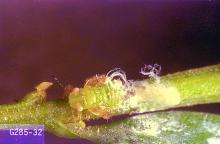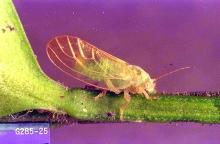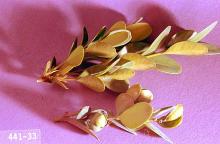Psylla buxi
Pest description and crop damage The greenish, aphid-like adult psyllids are about 0.125 inch long. The adults jump, and can even bite, although this is not serious. The immature psyllids (nymphs) are covered with a white, waxy secretion that gives them a cottony look. The nymphs feed on the developing buds and new growth. The presence of the boxwood psyllid is indicated by the cupping of leaves at the tips of terminals. Buds in cupped leaves often are dead. Honeydew, a shiny, sticky material produced by the insects, may be present. The honeydew may become covered with a growth of black sooty mold.
Biology and life history The insect overwinters as spindle-shape orange eggs under bud scale on boxwood. As the buds begin to open, the eggs hatch and the nymphs begin to feed. Adults can be found by late May. The adult females lay their eggs under the bud scale. There is only one generation per year.
Management-biological control
Ladybird beetles, lacewings, and parasitic wasps are all effective controls for this pest. Avoid the use of broad-spectrum sprays which would disrupt these controls.
Management-cultural control
English boxwood (Buxus sempervirens) is reportedly less susceptible.
Management-chemical control
See:
Chemical Control of Nursery Pests
For more information
Johnson, W.T. and H.H. Lyon (1991), Insects That Feed on Trees and Shrubs, 2nd ed., Cornell University Press (p. 290).
PNW Nursery IPM: Boxwood psyllid (https://agsci.oregonstate.edu/nurspest/insects/boxwood-psyllid)




